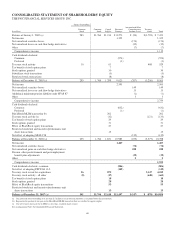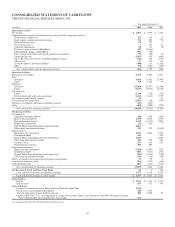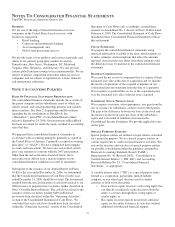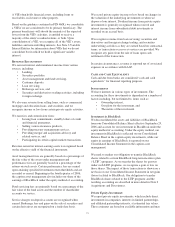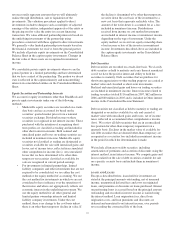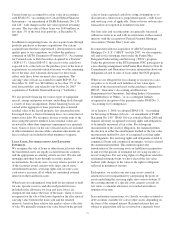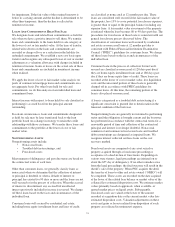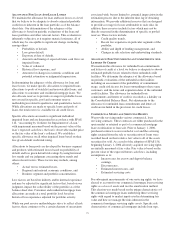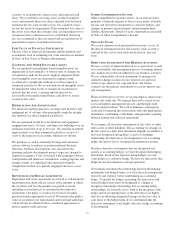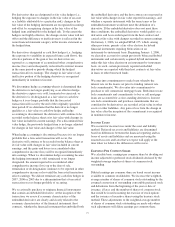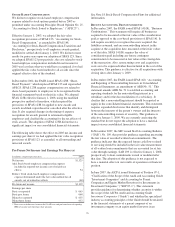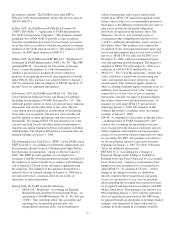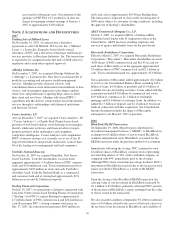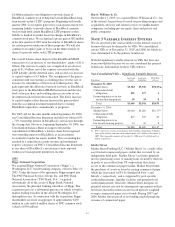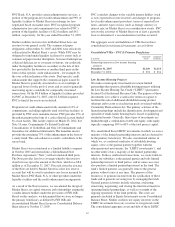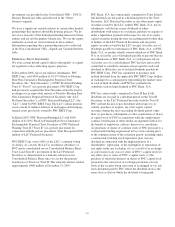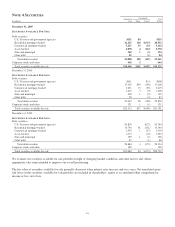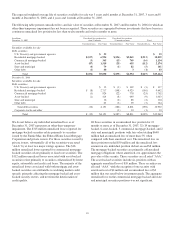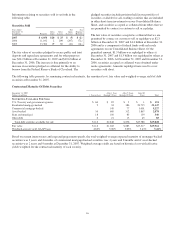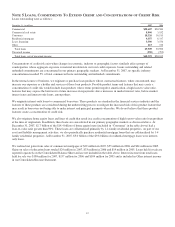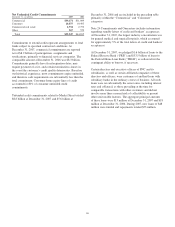PNC Bank 2007 Annual Report Download - page 83
Download and view the complete annual report
Please find page 83 of the 2007 PNC Bank annual report below. You can navigate through the pages in the report by either clicking on the pages listed below, or by using the keyword search tool below to find specific information within the annual report.
S
TOCK
-B
ASED
C
OMPENSATION
We did not recognize stock-based employee compensation
expense related to stock options granted before 2003 as
permitted under Accounting Principles Board Opinion No. 25,
“Accounting for Stock Issued to Employees,” (“APB 25”).
Effective January 1, 2003, we adopted the fair value
recognition provisions of SFAS 123, “Accounting for Stock-
Based Compensation,” as amended by SFAS 148,
“Accounting for Stock-Based Compensation-Transition and
Disclosure,” prospectively to all employee awards granted,
modified or settled after January 1, 2003. We did not restate
results for prior years upon our adoption of SFAS 123. Since
we adopted SFAS 123 prospectively, the cost related to stock-
based employee compensation included in net income for
2005 was less than what we would have recognized if we had
applied the fair value based method to all awards since the
original effective date of the standard.
In December 2004, the FASB issued SFAS 123R “Share-
Based Payment,” which replaced SFAS 123 and superseded
APB 25. SFAS 123R requires compensation cost related to
share-based payments to employees to be recognized in the
financial statements based on their fair value. We adopted
SFAS 123R effective January 1, 2006, using the modified
prospective method of transition, which required the
provisions of SFAS 123R be applied to new awards and
awards modified, repurchased or cancelled after the effective
date. It also required changes in the timing of expense
recognition for awards granted to retirement-eligible
employees and clarified the accounting for the tax effects of
stock awards. The adoption of SFAS 123R did not have a
significant impact on our consolidated financial statements.
The following table shows the effect on 2005 net income and
earnings per share if we had applied the fair value recognition
provisions of SFAS 123, as amended, to all outstanding and
unvested awards.
Pro Forma Net Income And Earnings Per Share (a)
In millions, except for per share data 2005
Net income $1,325
Add: Stock-based employee compensation expense
included in reported net income, net of related tax
effects 54
Deduct: Total stock-based employee compensation
expense determined under the fair value method for all
awards, net of related tax effects (60)
Pro forma net income $1,319
Earnings per share
Basic-as reported $ 4.63
Basic-pro forma 4.60
Diluted-as reported $ 4.55
Diluted-pro forma 4.52
(a) There were no differences between the GAAP basis and pro forma basis of reporting
2006 net income and related per share amounts.
See Note 18 Stock-Based Compensation Plans for additional
information.
R
ECENT
A
CCOUNTING
P
RONOUNCEMENTS
In December 2007, the FASB issued SFAS 141(R), “Business
Combinations.” This statement will require all businesses
acquired to be measured at the fair value of the consideration
paid as opposed to the cost-based provisions of SFAS 141. It
will require an entity to recognize the assets acquired, the
liabilities assumed, and any noncontrolling interest in the
acquiree at the acquisition date, measured at their fair values
as of that date. SFAS 141(R) requires the value of
consideration paid including any future contingent
consideration to be measured at fair value at the closing date
of the transaction. Also, restructuring costs and acquisition
costs are to be expensed rather than included in the cost of the
acquisition. This guidance is effective for all acquisitions with
closing dates after January 1, 2009.
In December 2007, the FASB issued SFAS 160, “Accounting
and Reporting of Noncontrolling Interests in Consolidated
Financial Statements, an amendment of ARB No. 51.” This
statement amends ARB No. 51 to establish accounting and
reporting standards for the noncontrolling interest in a
subsidiary and for the deconsolidation of a subsidiary. It
clarifies that a noncontrolling interest should be reported as
equity in the consolidated financial statements. This statement
requires expanded disclosures that identify and distinguish
between the interests of the parent’s owners and the interests
of the noncontrolling owners of an entity. This guidance is
effective January 1, 2009. We are currently analyzing the
standard but do not expect the adoption to have a material
impact on our consolidated financial statements.
In November 2007, the SEC issued Staff Accounting Bulletin
(“SAB”) No. 109, that provides guidance regarding measuring
the fair value of recorded written loan commitments. The
guidance indicates that the expected future cash flows related
to servicing should be included in the fair value measurement
of all written loan commitments that are accounted for at fair
value through earnings. SAB 109 is effective January 1, 2008,
prospectively to loan commitments issued or modified after
that date. The adoption of this guidance is not expected to
have a material effect on our results of operations or financial
position.
In June 2007, the AICPA issued Statement of Position 07-1,
“Clarification of the Scope of the Audit and Accounting Guide
“Investment Companies” and Accounting by Parent
Companies and Equity Method Investors for Investments in
Investment Companies” (“SOP 07-1”). This statement
provides guidance for determining whether an entity is within
the scope of the AICPA Audit and Accounting Guide
Investment Companies (“Guide”) and whether the specialized
industry accounting principles of the Guide should be retained
in the financial statements of a parent company of an
investment company or an equity method investor in an
78


